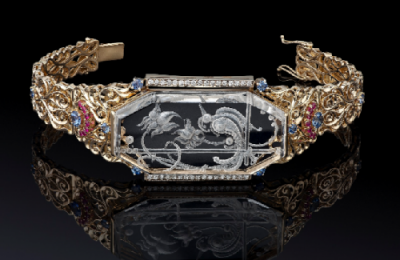
Art Nouveau Belgian silver went down in jewelry history thanks to Phillipe Wolfers, who worked in Brussels at the turn of the 19th and 20th centuries. By this period, the public was tired of the heavy Victorian jewelry with many non-styles and yearned for something new. The emergence of Art Nouveau was greeted with enthusiasm – at first the new direction was picked up by French and German masters, and then it spread everywhere.
Belgian silver by Wolfers is usually compared with the work of the outstanding French jeweler René Lalique. Both artists used similar techniques and techniques, but Wolfers’ work is distinguished by a great earthiness and a penchant for naturalism.

Philip Wolfers – founder of Belgian silver Art Nouveau
Belgian silver was heavily influenced by French fashion, and it was only Wolfers’ art nouveau creations that took the country’s jewelry art to a whole new level. The master was born into a family of a jeweler – his father’s company had been operating in Brussels since 1850. The small company did not have its own stores, so it supplied its jewelry to leading European houses, including Cartier in France and Goldschmidt in Germany. Philip studied at the Brussels Art Academy, and during his business trips to Europe made many sketches and sketches.
In 1872, the jeweler visited the World Exhibition in Vienna, where he was amazed at the work of Japanese craftsmen. The first projects of his works in silver are imbued with motives of nature, characteristic of the East. Another important source of inspiration for the Belgian was the work of artists and sculptors of the Renaissance.

In 1893, Philip opened his own workshop on the Place Marie-Louise in Brussels, and a year later he made his debut with his works at an exhibition in Antwerp, where he immediately gained international fame. More than one and a half hundred masterpieces of Art Nouveau jewelry were created according to Wolfers’ projects, among which were not only jewelry, but also sculptures, vases and lamps. The craftsman applied the “ex unique” mark to the items to distinguish them from the products that were produced in the family company.

Materials and technique of Philip Wolfers
The favorite materials for the master were silver and ivory from the Congo, with which none of the jewelers had worked before him. Many amazing products were created using the plique-a-jour technique, which was widespread during this period. An extremely difficult job involves applying the enamel to the precious metal cells filled with glass. In this case, no substrate is used, thanks to which the product remains translucent, and the result resembles a stained glass window in miniature.
Belgian interpretations of Art Nouveau were heavier than French ones. The master introduced a sense of anxiety into his images, and the female nude figures in his performance were far from the airy nymphs of Rene Lalique.

Art Nouveau pieces by Wolfers broke all the conventions that existed in jewelry at the end of the 19th century. The master replaced traditional diamonds with carved semi-precious stones and glass. His products became famous as revolutionary thanks to new forms and materials and had a great influence on the development of world jewelry art.
During his lifetime, the jeweler did not strive to achieve success, and at the end of his career, he left jewelry making altogether, devoting himself entirely to sculpture. Currently, Wolfers’ works are highly valued at world antique auctions. In 2015, the Moth brooch was sold in the United States for $ 51,000.
Products















